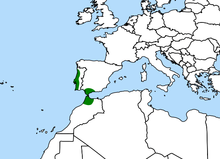Drosophyllum
This article needs additional citations for verification. (May 2013) |
| Drosophyllum | |
|---|---|

| |
| Drosophyllum lusitanicum in the wild | |
| Scientific classification | |
| Kingdom: | Plantae |
| Clade: | Tracheophytes |
| Clade: | Angiosperms |
| Clade: | Eudicots |
| Order: | Caryophyllales |
| Family: | Drosophyllaceae Chrtek, Slaviková & Studnička[1] |
| Genus: | Drosophyllum Link |
| Species: | D. lusitanicum
|
| Binomial name | |
| Drosophyllum lusitanicum (L.) Link
| |

| |
| Drosophyllum distribution | |
| Synonyms | |
| |
Drosophyllum (/ˌdrɒsoʊˈfɪləm/ DROSS-oh-FIL-əm, rarely /drəˈsɒfɪləm/ drə-SOF-il-əm) is a genus of carnivorous plants containing the single species Drosophyllum lusitanicum, commonly known as Portuguese sundew or dewy pine. In appearance, it is similar to the related genus Drosera (the sundews), and to the much more distantly related Byblis (the rainbow plants).
Description

Drosophyllum lusitanicum is a
The 10–20 cm (3.9–7.9 in)
Distribution and habitat
Drosophyllum lusitanicum is native to the western
Ecology

The plant has a distinct sweet aroma, which attracts the insects upon which it preys. When insects land on the leaves, they find themselves stuck to the mucilage secreted by the stalked glands on the leaves. The more the insects struggle, the more ensnared they become, ultimately dying of suffocation or exhaustion. The plant then secretes enzymes which dissolve the insects and release the nutrients, which are then absorbed by the plant. The plant uses these nutrients to supplement the nutrient-poor soil in which it grows.
The genus had always been assumed to be closely allied to
Classification
The
Recent molecular and biochemical evidence (see the AP-Website) suggests the carnivorous taxa in the order
-
Drosophyllum lusitanicum flower
-
Drosophyllum lusitanicum in its native habitat in gravel soil
-
Detail of the coiling process and mucilaginous glands viscosity
-
Drosophyllum lusitanicum seedling (note the pear-shaped seed on the bottom)
-
An illustration of the mucilaginous glands by Darwin
References
- hdl:10654/18083.
- ^ a b c "Drosophyllum" (PDF). Flora Iberica. Retrieved 27 January 2021.
- .
- ^ "Drosophyllum lusitanicum (L.) Link". Flora-On. Retrieved 27 January 2021.





